The dust of the quarter-finals has now settled, and the Women’s Euros’ penultimate rounds have been decided. England will take on Sweden while Germany will battle it out against France.
These are two incredibly exciting fixtures to leave supporters watering at the mouth in anticipation. The quality on display will be awe-inspiring while more analytical nerds like ourselves get to watch four great coaches work their magic from the sidelines.
Germany provide a familiar face in the semi-finals of the illustrious and ever-growing competition. Die Nationalelf have won the Women’s Euros more than any other nation since its inauguration back in 1982.
The eight-time champions, managed by the wonderful Martina Voss-Tecklenburg, are on course for their ninth title but will have to bypass a stern and stellar French team under the tutelage of the stubborn yet sterling Corinne Diacre.
Despite rumours of Diacre losing the dressing room due to her divisive squad announcement prior to the tournament’s commencing, France have surprised many by getting this far and have now put themselves into contention to win it outright.
Germany versus France, Voss-Tecklenburg against Diacre, this will be a must-watch semi-final of the highest quality, and we are here to preview it for you in the only way we know how – tactical analysis!
This analysis will be a preview of the Euros clash, looking at what tactics we can expect from the two titans of Europe and how they can look to exploit one another at the Stadium MK.
Battle of the 4-3-3s
While there is no guarantee, it’s likely that both Germany and France will set themselves up in a 4-3-3 in this crucial semi-final matchup. Both nations have been quite consistent with their usage of the conventional structure throughout the tournament thus far, although the French have been a little bit more persistent.
Voss-Tecklenburg has predominantly deployed a 4-3-3 during games, but against Austria in the quarter-final, the 54-year-old switched things up slightly, going with a 4-2-3-1, offering a little more balance in the middle of the park.
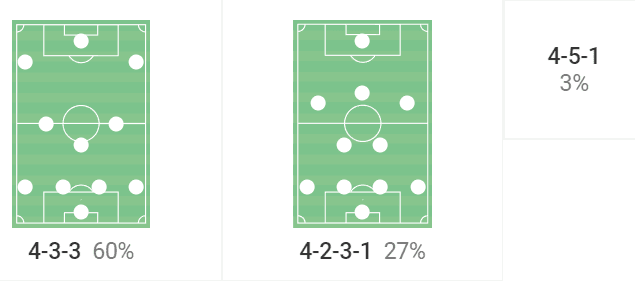
In this tournament so far, the 4-3-3, including its close cousin, the 4-5-1, have been used in 63 percent of Germany’s games, followed by the 4-2-3-1 in 27 percent.
Typically, the 20-year-old Lena Oberdorf sits in front of the backline as the single pivot, with Sara Däbritz and Lina Magull further forward as the advanced midfielders. However, against geographical and historical rivals Austria, Däbritz sat slightly deeper, forming a double-pivot with Oberdorf while Magull operated as a ‘10’ behind Alexandra Popp.
Voss-Tecklenburg may well revert back to her preferred 4-3-3 but the manager could also stick with the 4-2-3-1 which saw Germany cruise past the Austrians. It will all depend on how attacking Voss-Tecklenburg wants her side to be against the French.
For France, it’s quite certain that a 4-3-3 is on the cards unless Diacre opts to make a radical tactical change so late in the tournament. This formation has been practically all France have used in their previous four matches.
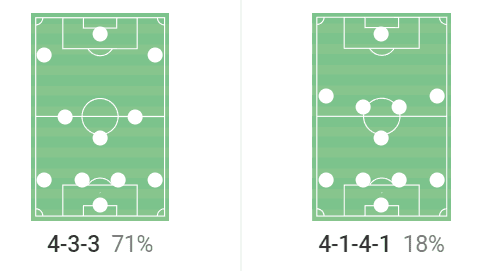
Across their matches in the Women’s Euros, Diacre has set her side up in the 4-3-3/4-1-4-1 in a total of 89 percent of their matches.
The structure allows the French to keep the ball and create as many triangles as possible to dominate possession, something they love to do, especially with a midfield trio of Charlotte Bilbault at the base while Grace Geyoro and Sandie Toletti are positioned further ahead.
So, this semi-final will either see two 4-3-3 systems locking horns or else the 4-2-3-1 against the 4-3-3.
How can France stifle and exploit Germany?
Germany are incredibly prolific, having scored 11 goals in four games already in the Euros. Stopping Die Nationalelf’s attacking prowess seems like an impossible task for the French but what looks more daunting is actually scoring against them.
Over the tournament’s entirety, Germany are yet to concede one single goal and have looked unbreakable during the defensive phases, pressing high while also being aggressive in deeper areas.
When Germany press teams high up the pitch, the first line of pressure are tasked with pressing inwardly as the high press is executed in a player-to-player fashion. This means that the players press the ball carrier from outside to in, forcing them to either go long or else play down the central areas.
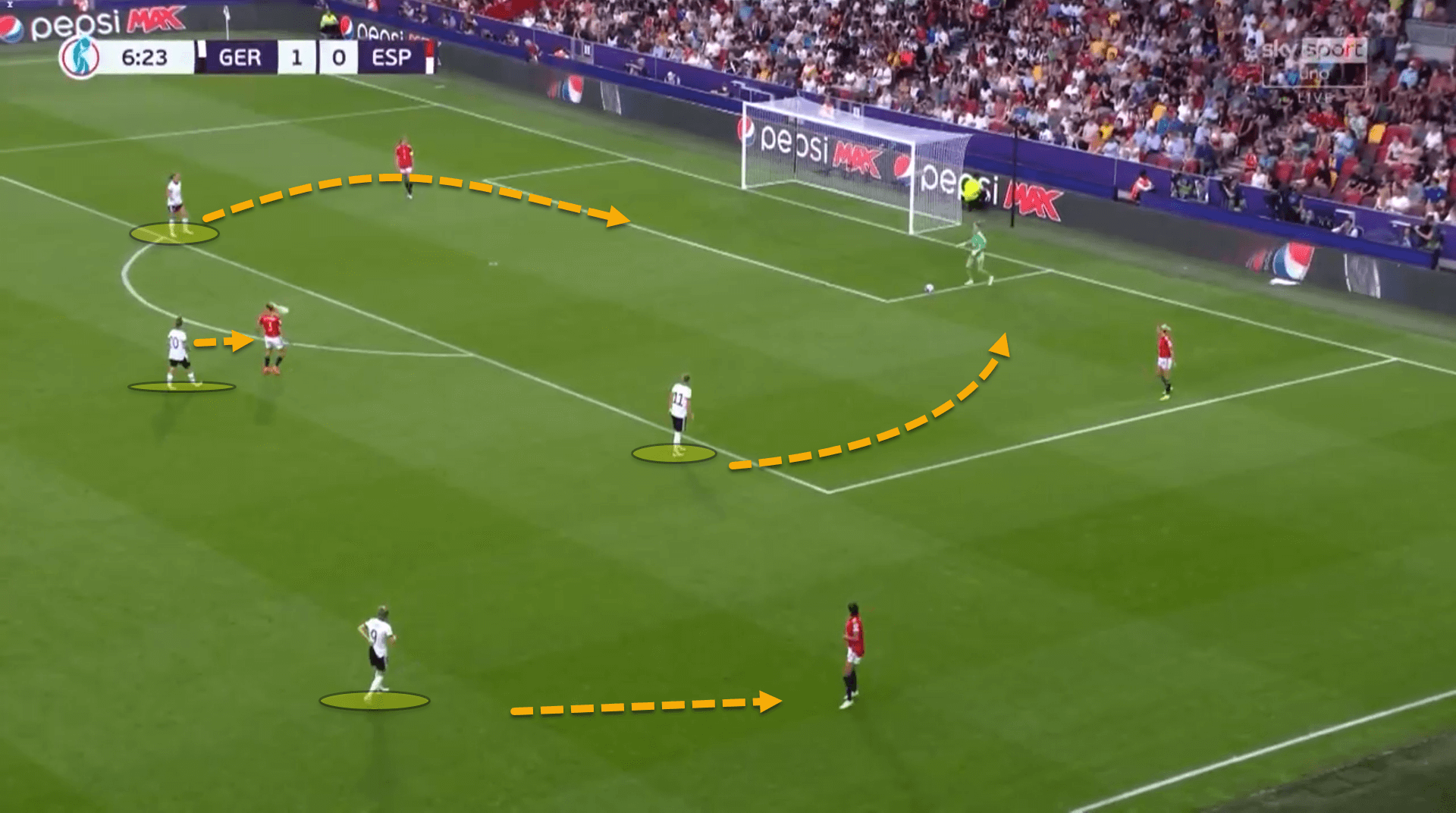
For instance, here, Germany have applied a player-oriented press against Spain who were trying to play out from the back.
When one of the centre-forwards pressed the Spanish goalkeeper, they would angle their run to cut off the passing lane into the nearest centre-back while the fullbacks were marked. Essentially, the opposition couldn’t play wide and were forced to try to play through the middle or else pump it long.
In fact, Germany scored from this exact situation against Jorge Vilda’s side in the group stages within two minutes.
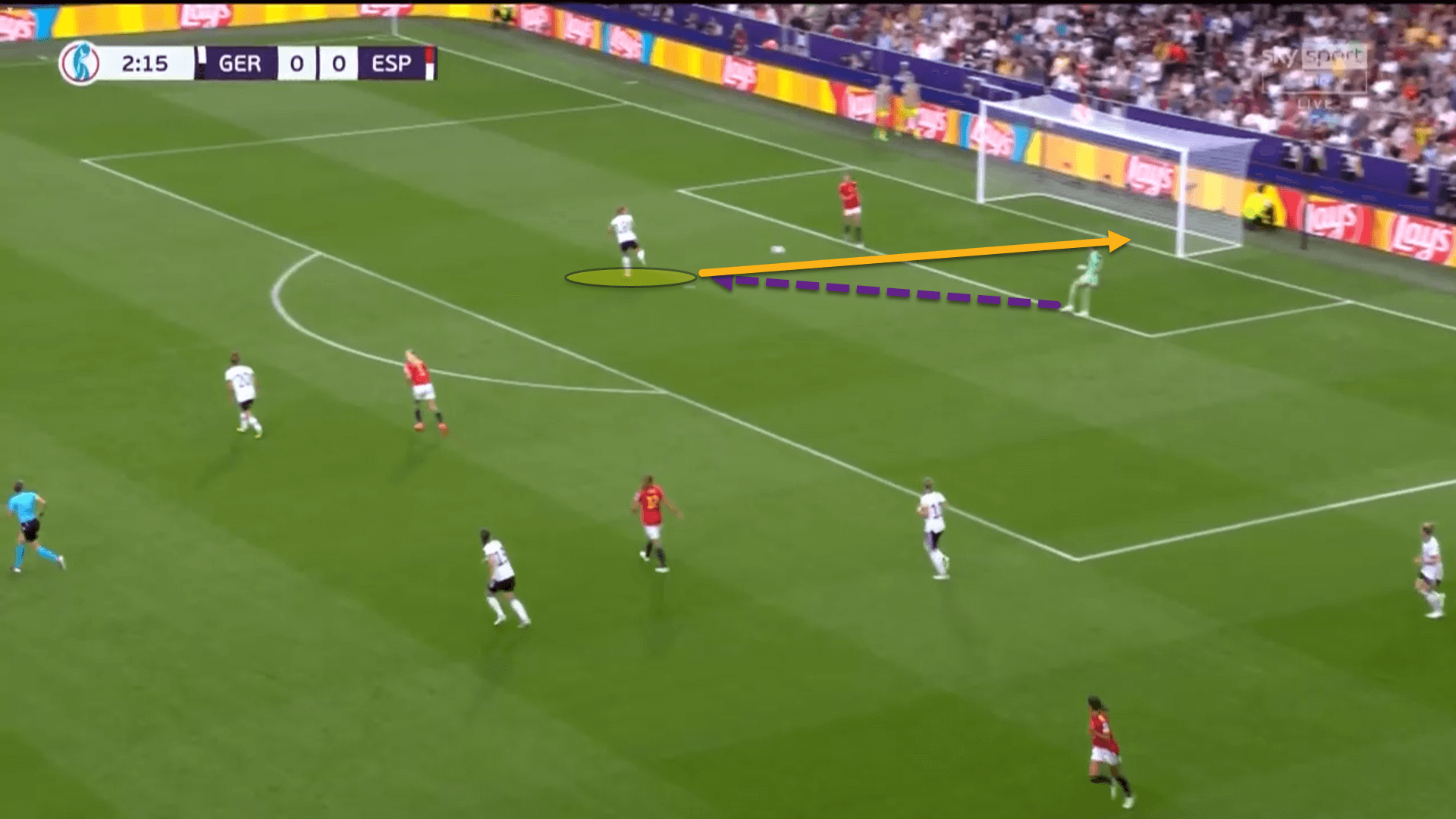
Germany’s left-winger Klara Bühl had blocked off the passing lane to Spain’s right-back. The goalkeeper Sandra Paños opted to play around her but failed miserably and Bühl intercepted the ball before poking home.
The German press is severely dangerous. Not only is it difficult to play out the wide areas because of their inverted pressure, but once the ball is passed into the central spaces, the Germany midfield steps up and aggressively closes down in a pressing trap to regain possession before quickly transitioning.
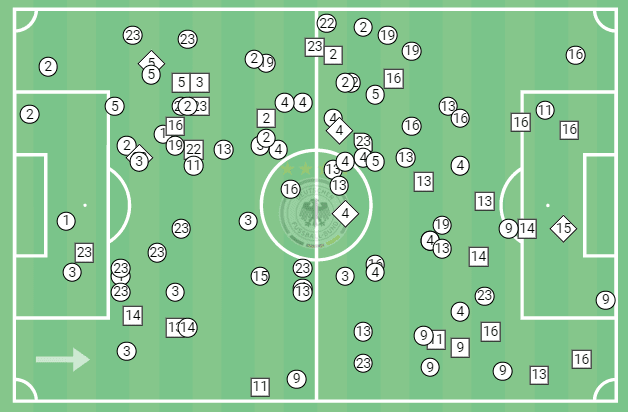
The data visual above plotted all 104 of Germany’s ball recoveries from their 3-0 victory against Finland in the group phase. The plain white circles represent ball recoveries through positioning in a structured defensive block.
Roughly half of Germany’s ball recoveries through positioning came in the opposition’s half while 38 percent were in the central corridors, which shows that their inside pressing traps work.
As France like to play out from the back, Diacre will be advising her players to be cautious when doing so. It’s likely that the French players will be given license to play longer passes up towards centre-forward Melvine Malard who has won 53.3 percent of her aerial duels so far in the Euros.
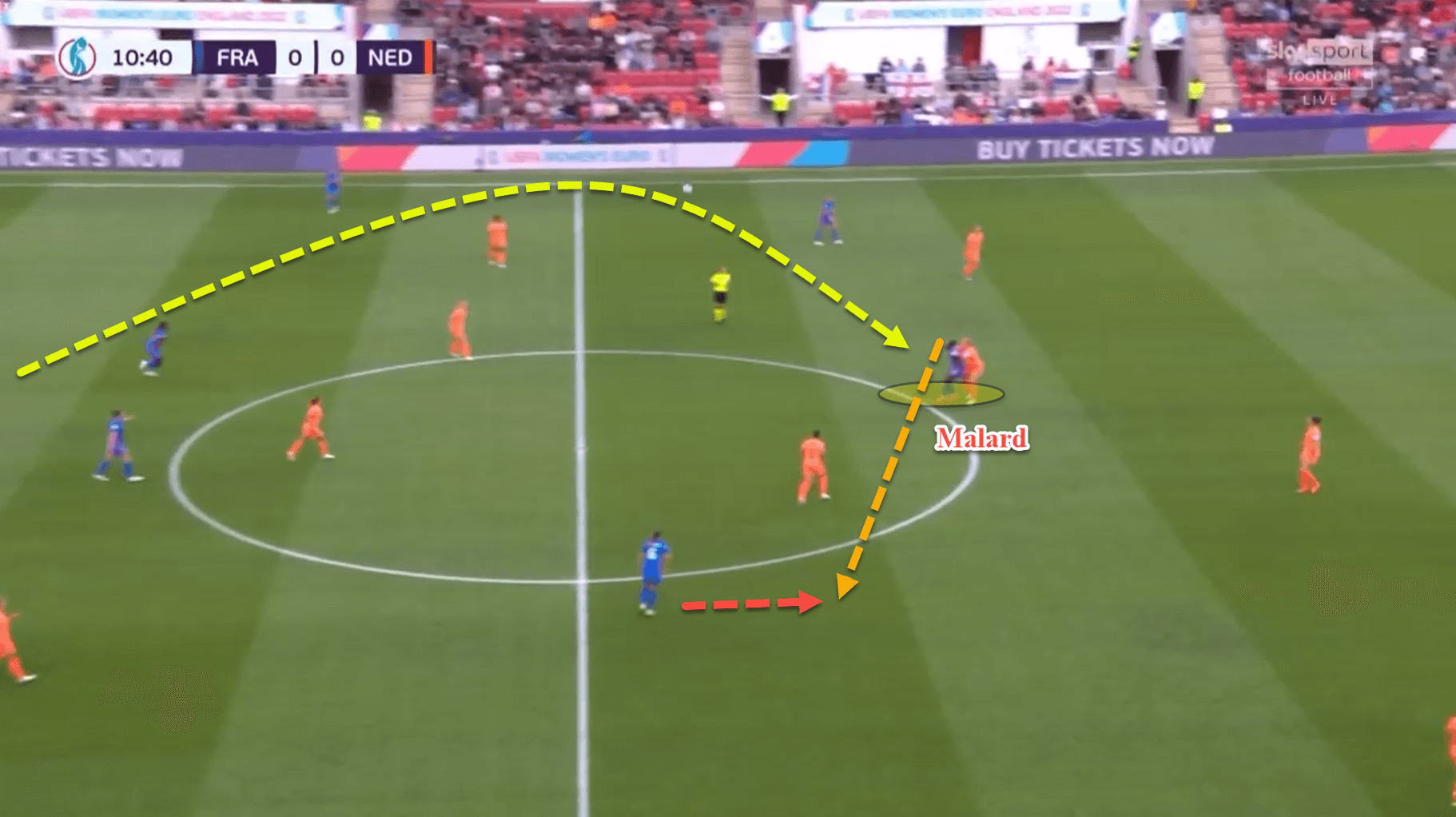
If you can’t beat the press, simply play over it. Risk-taking on such a massive stage could be detrimental to France should they attempt to bypass Germany’s excellent inward pressing.
Further down the pitch, as the Germans sit in a deeper defensive block, Voss-Tecklenburg also wants her side to be very aggressive. Germany defend in a zonal defensive block as a unit, but within this structure, each player must tightly mark anyone that steps into their personal zone.
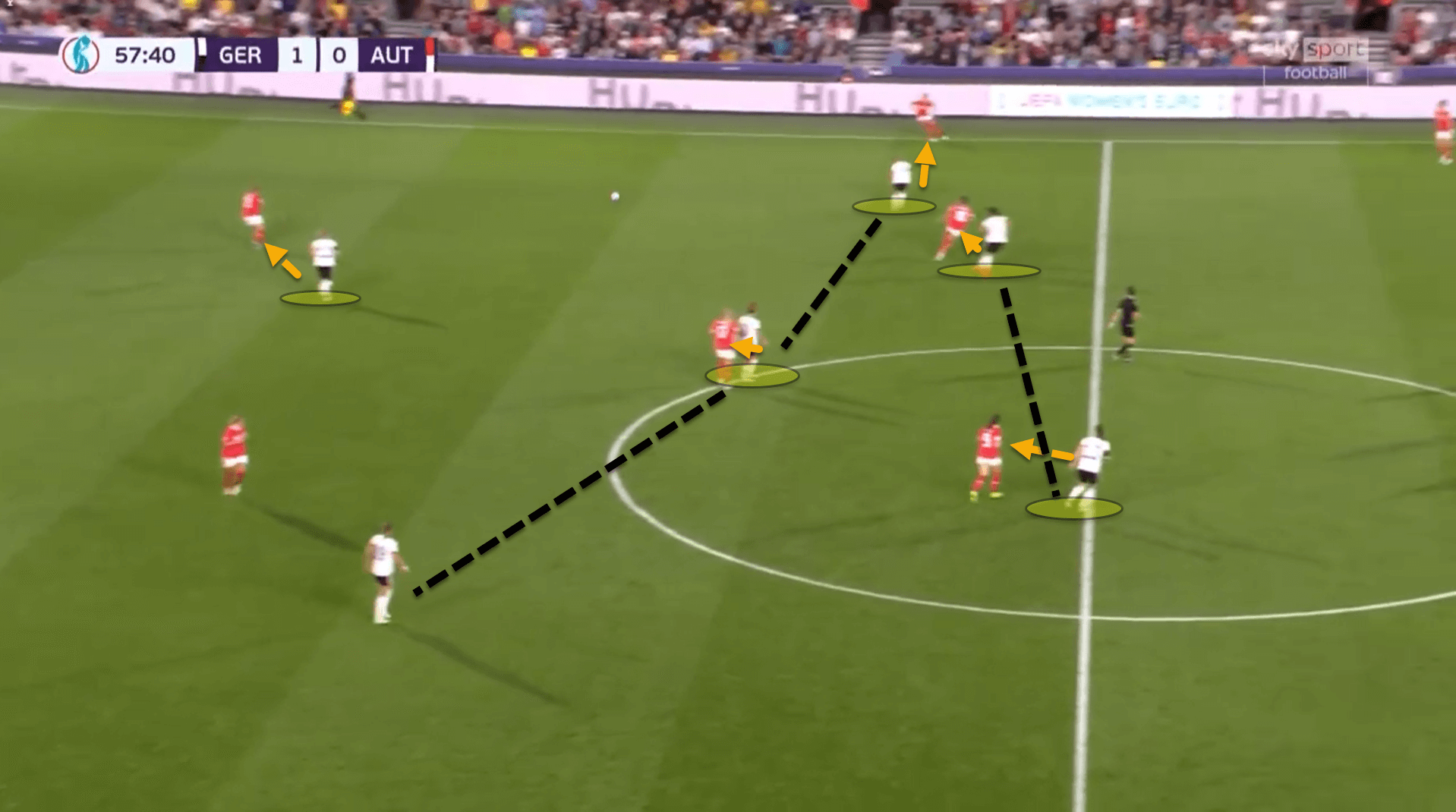
In this example, Germany are defending in a 4-2-3-1 mid-block while Austria are trying to play the ball from one half into the other. Die Nationalelf’s overall defensive block is zonal but some of the players are marking opponents that have drifted into their zones.
Germany have yet to concede and are usually fantastic in their defensive duels, having won 66 percent of their duels in the competition so far. However, there is a chance for France to be able to manipulate the Germans’ defensive shape by using third-person runs to get in behind their high line.
Following on from the previous image, Austria took advantage of Germany’s tight-marking approach:
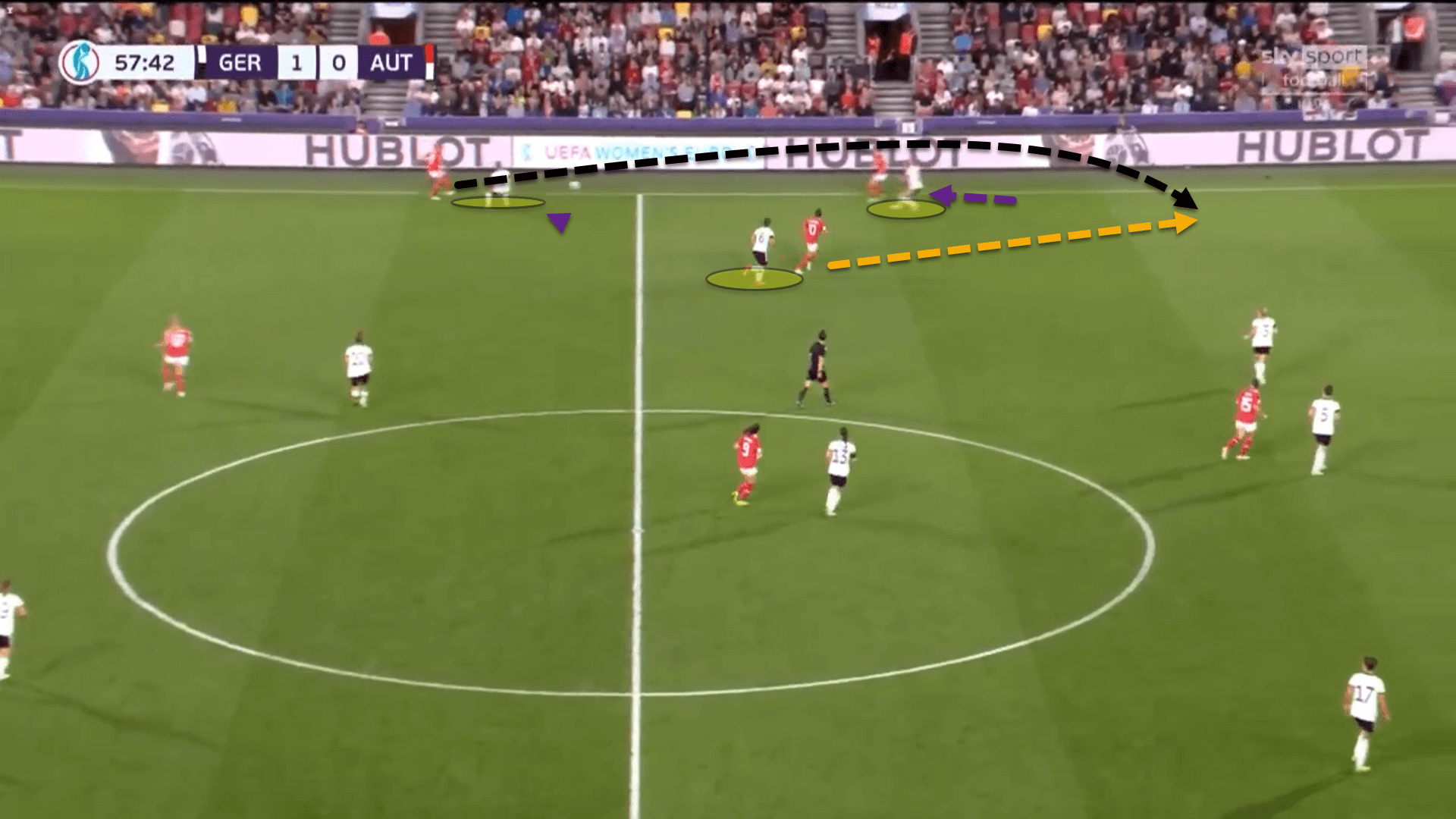
Germany’s right-back has stepped up to quickly close down the winger who has left space behind her to be exploited. Noticing this, the Austrian midfielder Laura Feiersinger makes a darting run in behind.
France use third-person runs all the time in order to break down defensive blocks with a higher line. Whether Marie-Antoinette Katoto plays or Malard, both are adept at dropping deep and linking up play, being used as wall-passes for third-person runs.
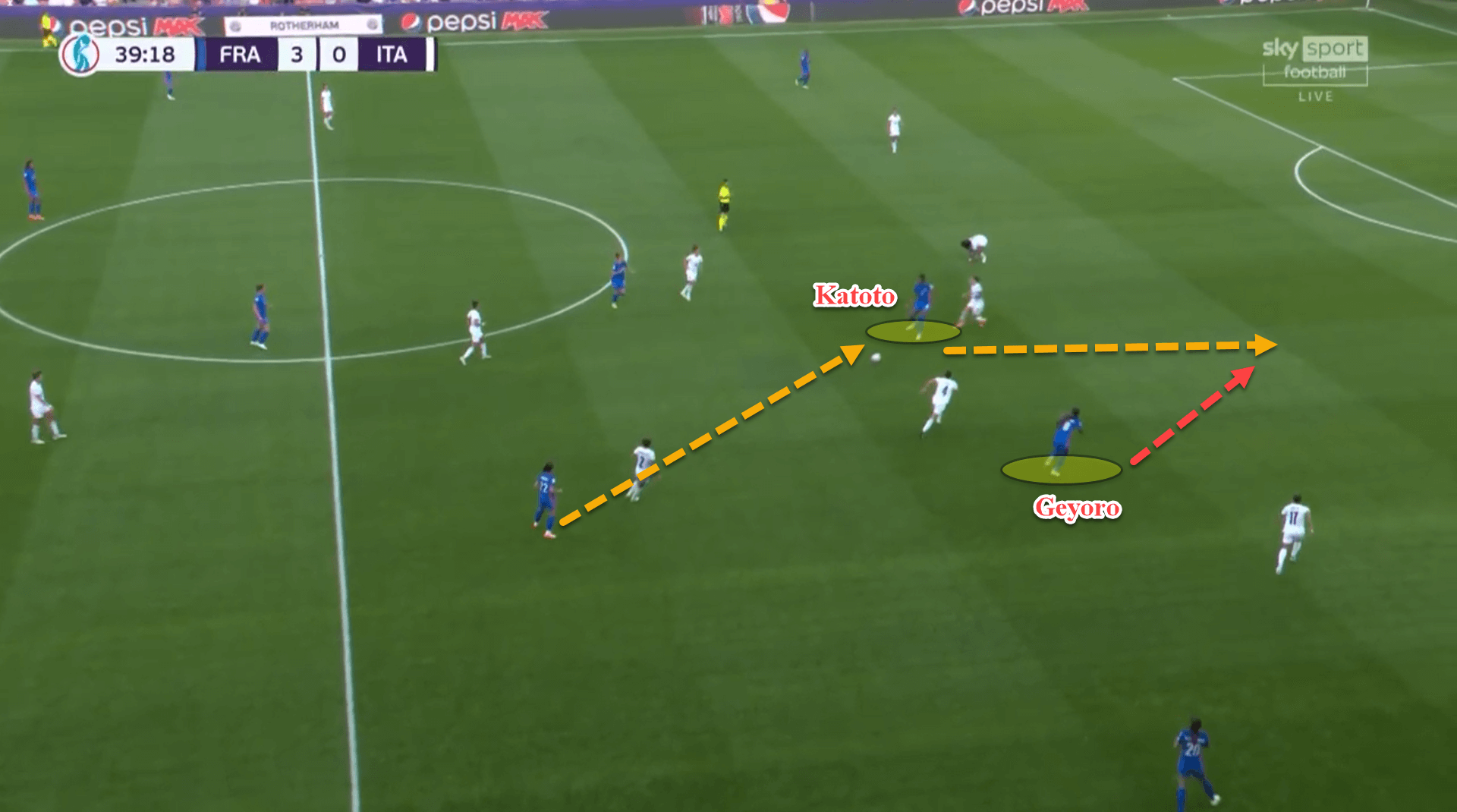
This pattern above led to France’s fourth goal against Italy and similar moves could do some serious damage to Germany’s aggressive high line but they must be played at pace.
How can Germany stop France?
France are a team that like to dominate possession. There is quite a high possibility that by the end of Wednesday night, Les Bleues will have had the lion’s share of the ball, as Germany are fine with sitting deeper and hitting teams on the break.
However, France’s possession style isn’t as retentive as a team like Manchester City or Barcelona in the men’s game. Diacre likes her side to be forward-thinking on the ball which can include long passes into the channels. This is something that France use quite a lot during the attacking phases.
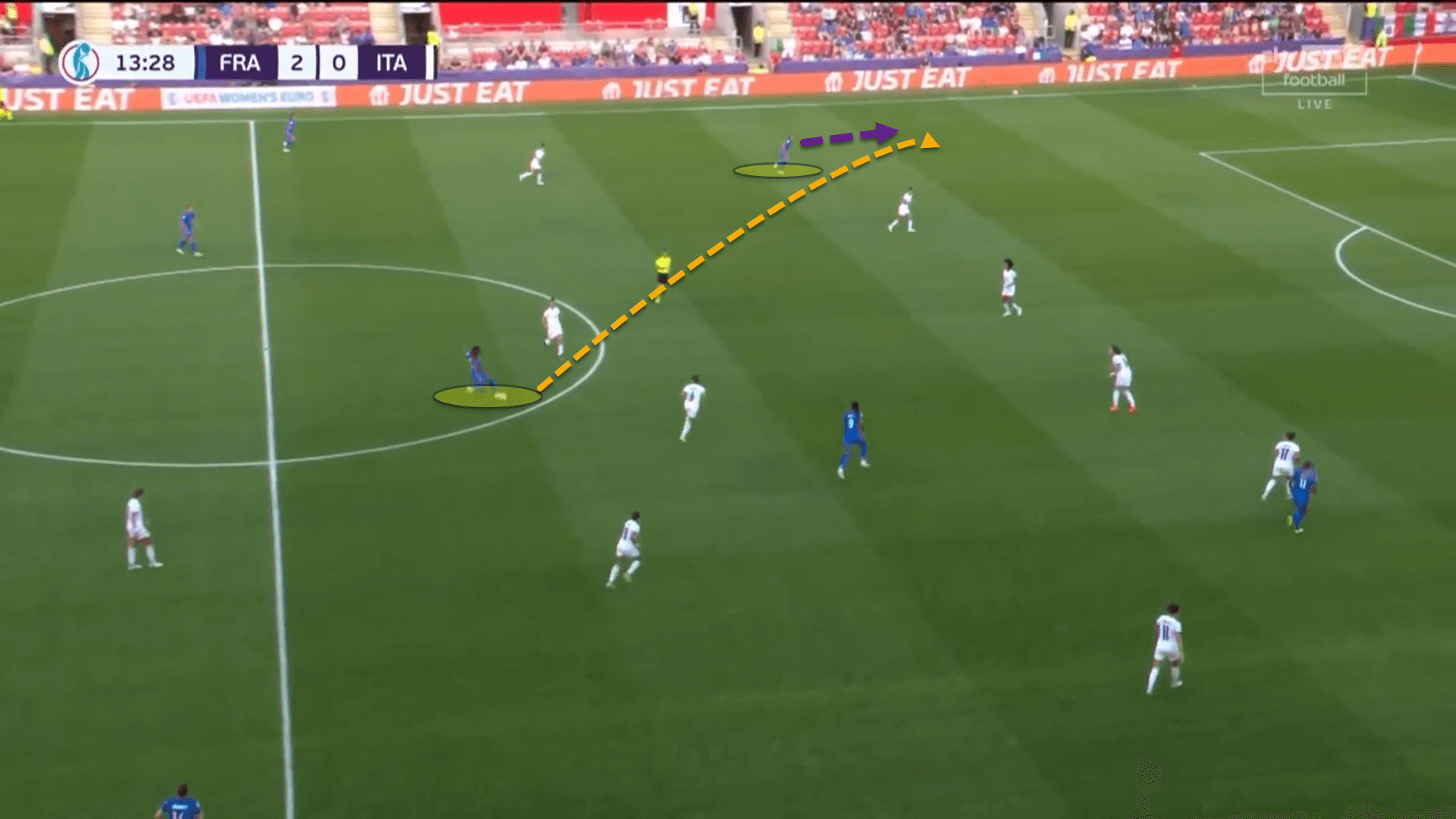
These long balls behind the opposition’s backline generally come from single pivot Bilbault or centre-back Wendie Renard as both women possess an incredible passing range.
Following on from the previous section’s analysis of how France can exploit Germany’s aggressive high line through third-person runs, the French can also take advantage by simply playing these channel balls to runners in behind.
These types of passes have been consistently used by Italy throughout the tournament thus far and so Die Nationaelf will need to be cautious of France’s ability to quickly change the pace of the attack by going longer into the channels.
This isn’t to say that Germany can’t employ a high line, defending as they so often do, even when sitting in a low block. But the centre-backs must hold good body posture to be ready to drop and chase a runner where necessary.
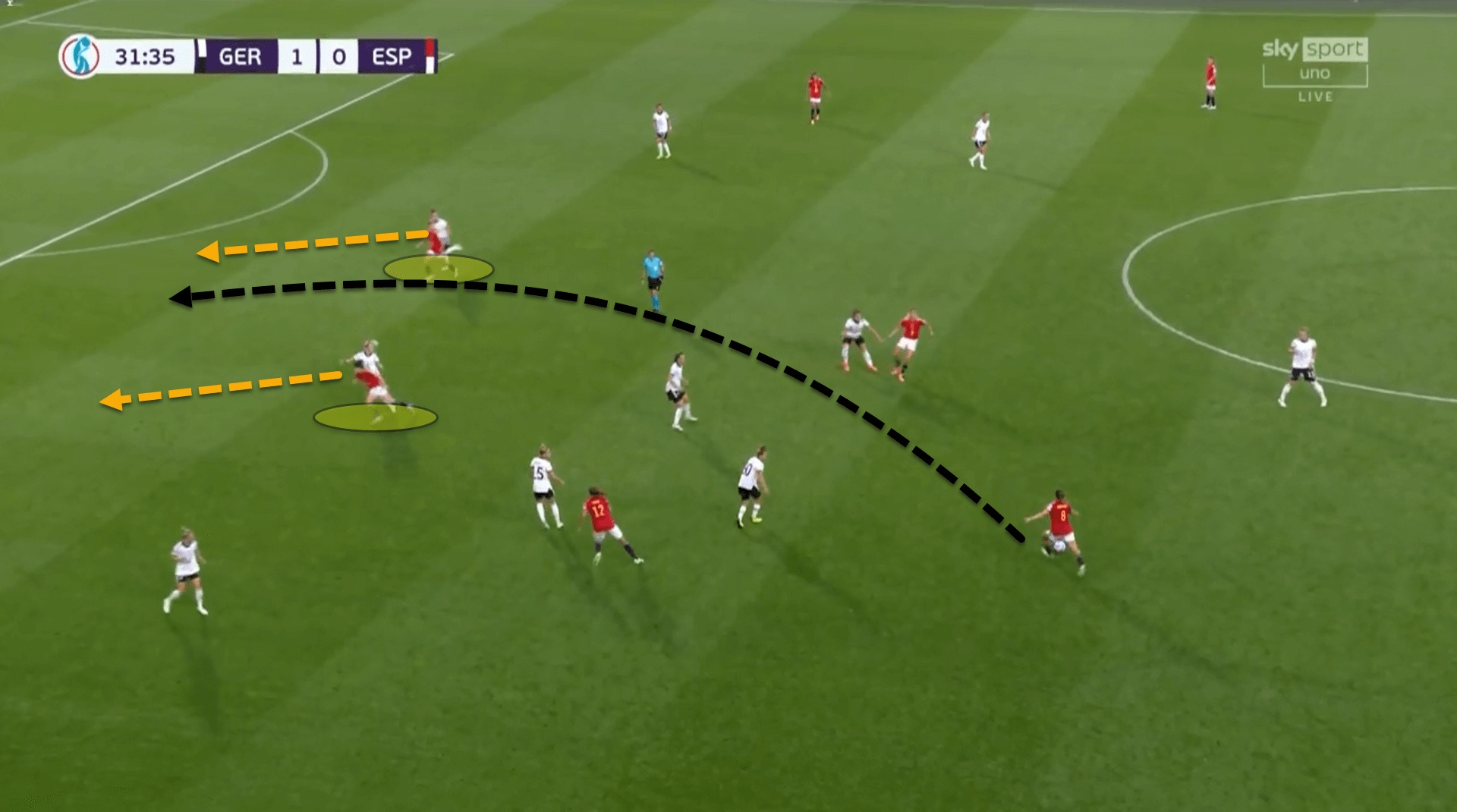
Here, the German centre-backs Marina Hegering and Kathrin Hendrich have excellent body orientation here to track their runners. By keeping a side stance, it allows the central defenders to be ready to step up when needed but also drop back in case of a ball in behind.
The two experienced centre-backs will need to constantly be ready to drop when France look to play these types of passes behind them or else their perfect defensive record could be on the ropes.
On the flip side, the Germans could also exploit France’s high line when playing out from the back. Like Germany, France press high. However, instead of pressing inward, Les Bleues force their opponents wider.
Initially, France set up in a zonal press in the central areas but once the ball is moved wider, they aggressively press in a player-oriented fashion. Even the fullbacks step higher, which leaves space in behind to be exploited.
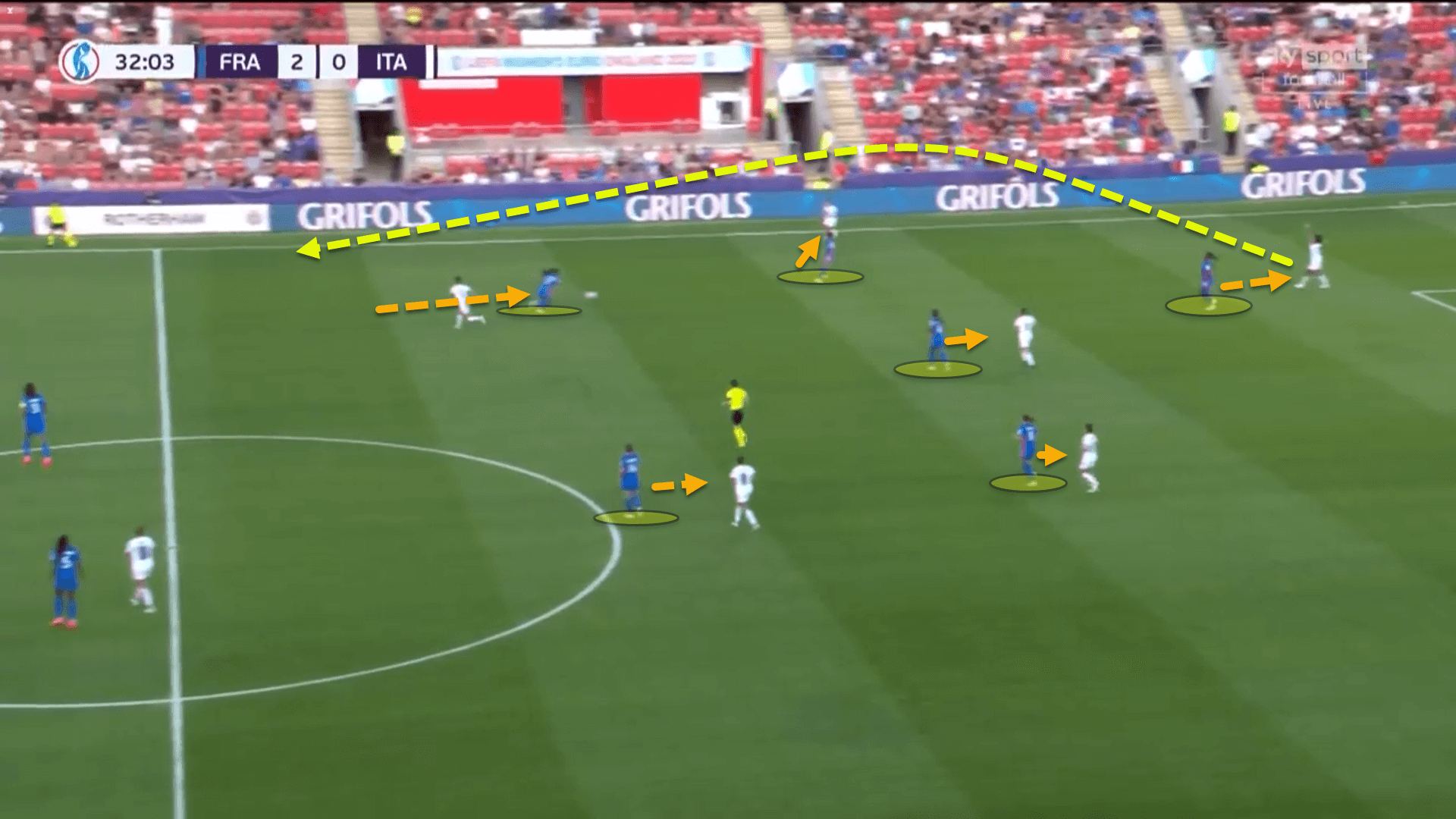
In this example, France had forced Italy to the left flank where they were able to aggressively close down the opponents in a player-to-player fashion. Even the left-back Sakina Karchaoui stepped up to tightly press the Italian winger.
However, as there was no room to play into, Italy’s right-winger quickly spun away from Karchaoui and ran in behind in the open channel. The centre-back tried to find her with a long pass but it fell short, allowing the left-back to intercept it.
Nevertheless, this can be something that Germany get in behind France with, using their wide players and trying to get the wingers into 1v1 battles against the French centre-backs. The long passes in behind the France fullbacks will need to be precise, but if pulled off, can wreak havoc.
Deep counterattacking vs high counterpressing
Both sides counterpress and counterattack, but Germany are much better at the former in the higher areas of the pitch while France excel at the latter in the deeper parts, making for a perfect battle between the two European titans.
Upon losing possession of the ball in the final third, Germany are extremely aggressive at stepping up as a unit to counterpress in order to regain possession. This is a very high-risk, high-reward strategy from Die Nationalelf.
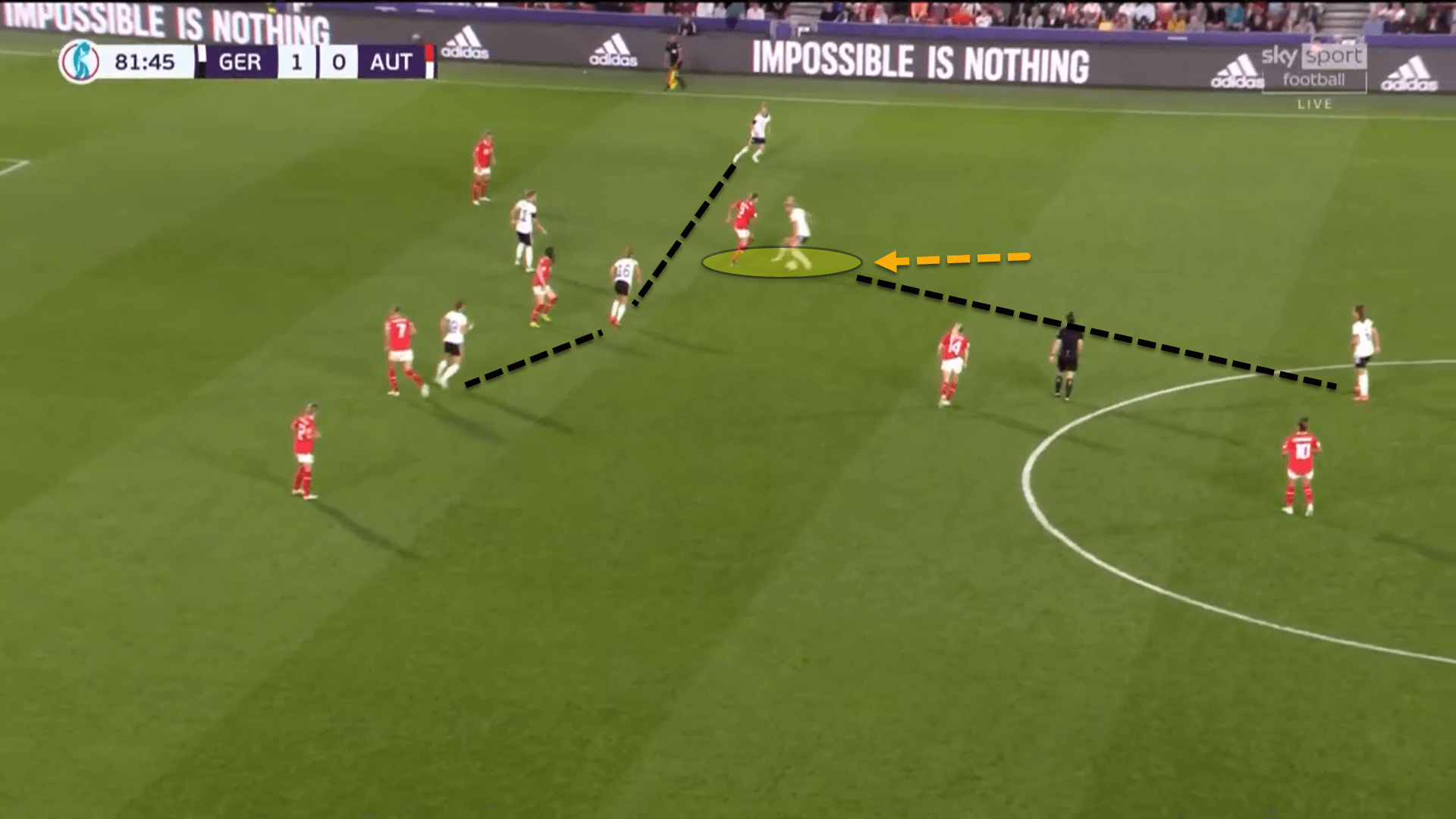
For instance, here, in the 82nd minute of a game with just one goal to separate the two sides, Germany have lost possession of the ball in the final third.
Instantly, the right pivot player Lena Lattwein steps up in their 4-2-3-1 shape to close down the ball carrier. Lattwein is successful in her defensive duel, nicks the ball, and slides it through to the German forward.
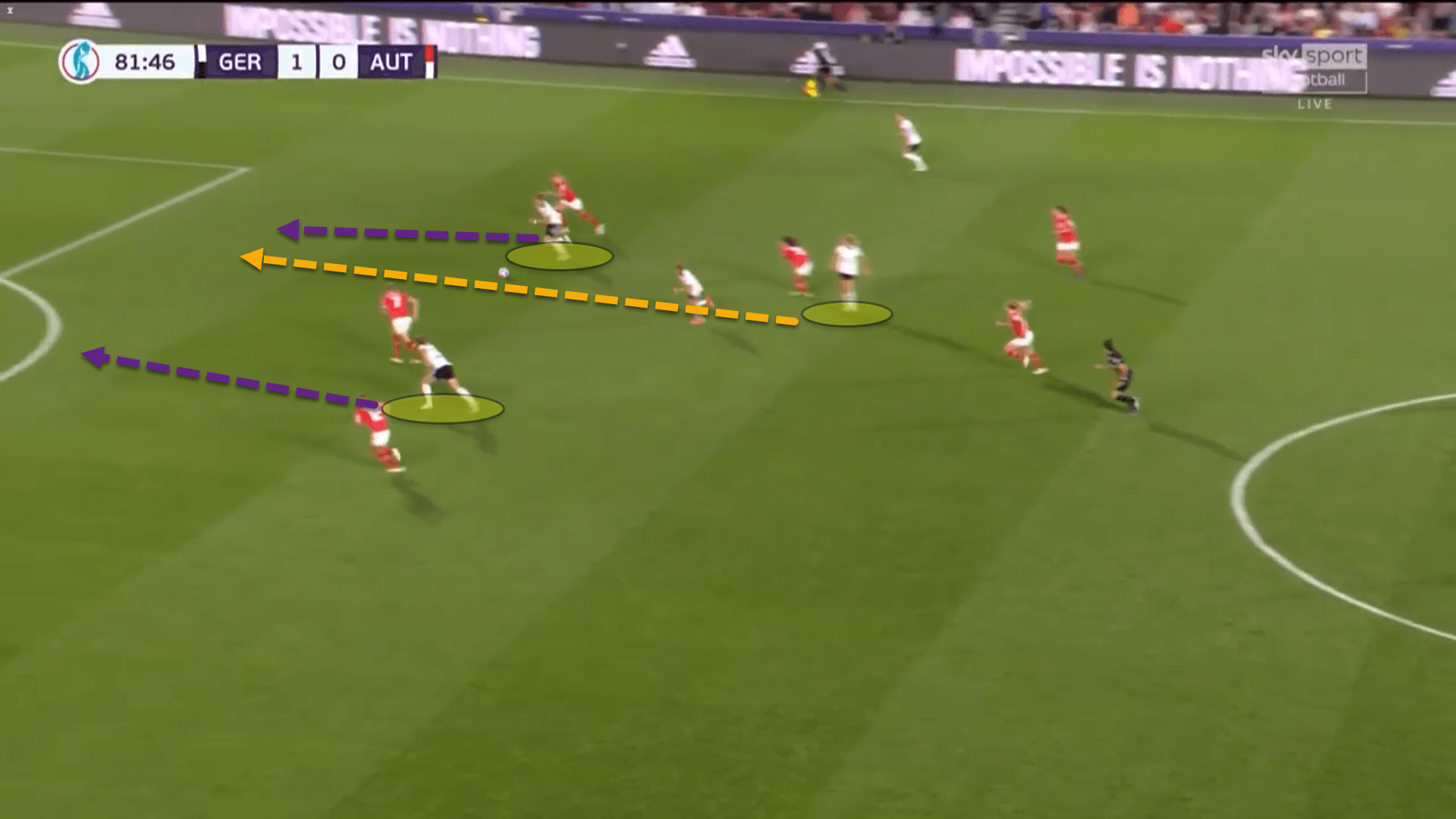
Somehow, Bühl placed a 0.44 xG shot wide of the mark but the counterpressing into a goalscoring opportunity was reminiscent of Jurgen Klopp’s Liverpool, a truly remarkable piece of transitional play by Voss-Tecklenburg’s side.
Germany are really efficient in their counterpressing, making it difficult for teams to break their net. However, France are one of the tournament’s best sides for counterattacking from deep.
Over the course of the competition. Les Bleues have averaged 2 counterattacks per game, with 62.5 percent ending in a shot on goal. In comparison, France’s four opponents so far have averaged just 0.5 counterattacks per game with 50 percent resulting in a shot.
Stopping France’s pace, power and precision on the counter is something that the Netherlands struggled with on Sunday night. Mark Parsons’ side did try and counterpress high once they lost the ball in the final third, but the French consistently bypassed this defensive strategy, leaving the backline exposed.
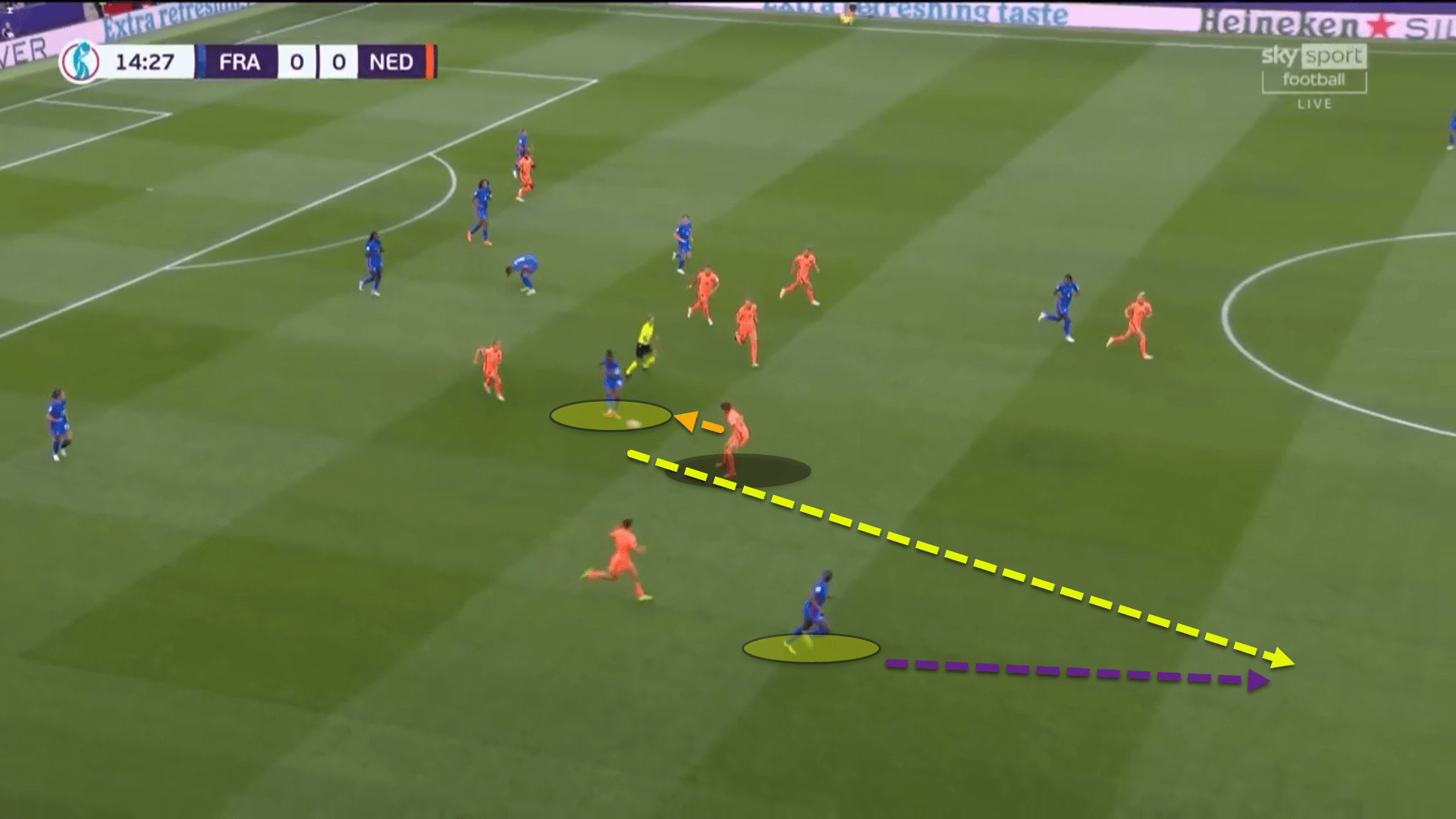
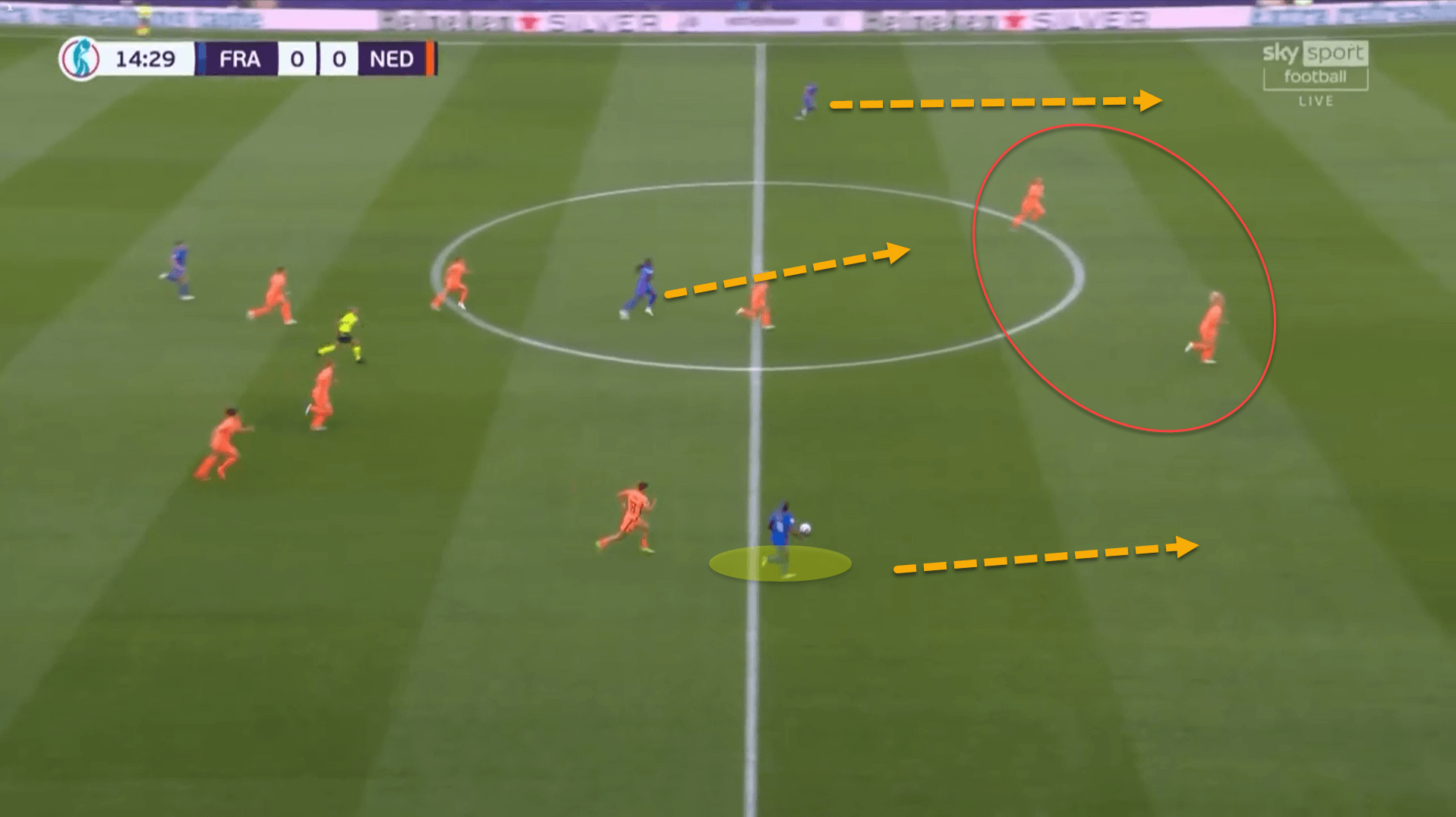
This will be a truly scintillating and intriguing showing to see which tactic comes out on top. Will Germany’s aggressive counterpress stifle France’s blistering counterattack or will the French break the German’s counterpressing net like a hand through a spider web?
Conclusion
The quality on display in this matchup will be a true sight to behold. Both teams have world-class stars in their ranks but the tactical clashing of two astute, yet stubborn strategists will be the underlying main event.
It will be interesting to see whether either Voss-Tecklenburg or Diacre tweak their usual tactical setup to try and protect their teams from the opponent’s strengths. Often, in football and in life, if you can’t learn to bend then you will break. One of these teams will be broken by the end of the match.





Comments